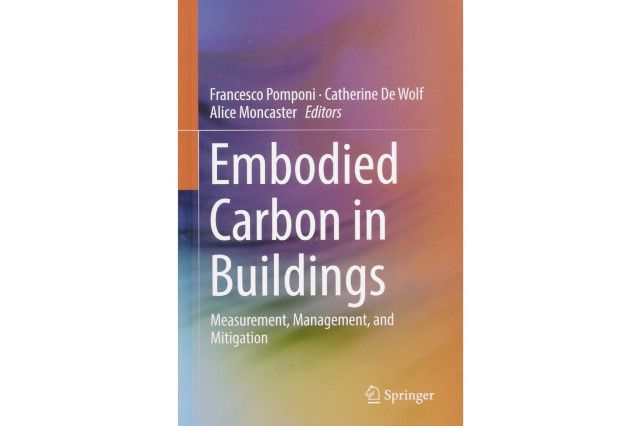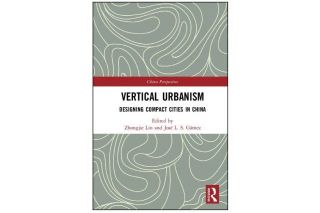
www.buildingsandcities.org/insights/reviews/embodied-carbon-in-buildings.html
Embodied Carbon in Buildings: Measurement, Management and Mitigation

Edited by Francesco Pomponi, Catherine de Wolf & Alice Moncaster. Springer, 2018, ISBN: 9783319727967
Antonín Lupíšek (Czech Technical University in Prague) considers how this book on embodied carbon fills a knowledge gap in our understandings about the environmental impacts of the building stock. He explores how the research, methods and practices in this important book can be harnessed in policy and practice.
Introduction
This significant monograph includes contributions by 55 authors and it appears at an important moment when communities worldwide are discussing the necessity and inevitability of the transition to zero carbon. Currently, one of the major contributors to rising greenhouse gas (GHG) concentrations is buildings: the way we operate them, the way we use them, but also the way we build and maintain them. The knowledge that we have on the contribution to climate change caused by the operation of buildings - energies, fuels and energy systems - is relatively established. However, there is still an information gap in the embodied impacts of the continuously growing and developing global building stock. This book is to be welcomed because it brings together a wealth of new knowledge and makes a compelling case for the inclusion of embodied carbon into our thought processes, calculations, practices and governance. It is essential reading and highly recommended to anyone who is serious about reducing the carbon footprint of buildings.
Contents
The editors structured the book in the three essential sections covering measurement, management, and mitigation; these are complemented by a fourth section documenting approaches to reducing embodied emissions of GHGs in buildings across global regions. The section on measurement presents several case studies and deals with various sources of uncertainty in building life-cycle analysis (LCA). It ranges from parameter and model uncertainties to those due to methodological choice and variability and presents an array of techniques and methods that can be helpful in managing them. It also brings new insights into probabilistic approaches and the inclusion of acute hazard consideration. The second section deals with the management of GHG calculations from the perspective of architectural practice and LCA practitioners. It presents methods, tools and databases that can be useful for many practitioners and researchers. The third section is about mitigation of the GHG through efficient building design strategies including chapters on the durability of building elements, reuse, recycling, and the wider application of circular economic principles. The chapter by Finnegan presents a much needed comparison of embodied carbon of various sustainable building technologies and renewable energy sources. Thorough planning of the construction process and site logistics are the subject of the chapter by Hammad et al. Special attention is given to tall buildings, that will shape the future in dense urban areas. The fourth part describes various approaches to the challenge of reducing the embodied carbon in buildings across global regions - a vital issue because the building stock is expected to grow significantly in the developing world. It contains rich examples from Africa, Australia, China, Europe, North America and Latin America. The contribution from Kibwami & Tutesigensi presents a study on the potential benefits of implementation of a carbon trading scheme in Uganda's building sector. Crawford et al. provide a broad overview of current practices related to embodied carbon in buildings containing information on: databases; assessment methods; the role of the sustainablility certification schemes; and illustrates their development using interesting case studies of Australian construction projects. Hong et al. describe current Chinese policies, methods and frameworks for embodied carbon assessment across various spatial scales. Moncaster et al. discuss the current state of the art in Europe, including a broad cross-scale analysis of sixty building case studies conducted in IEA EBC Annex 57. De Wolf et al. presents initiatives, tools, assessment schemes and data sources that are used in North America. Pomponi & Campos review the state of the art of embodied and life cycle carbon assessments of buildings in Latin America.
Audience
Building LCA practitioners and sustainability consultants will find this book useful: it provides several examples of modelling different life cycle stages, together with possible simplifications that can lead to improved workability of the complex assessment and insights into systemic ways of dealing with uncertainties. For instance, the chapter by Ding represents a helpful overview of dealing with construction and demolition waste, whilst the chapter by Hammad et al. focuses on GHG embodied in transport activities during construction. Several chapters provide links to numerous case studies that can be further investigated and used as a source of practical skills and hints for available tools and databases used in various countries. In particular, the chapter by Moncaster et al. includes results from a complex analysis of 60 European case studies.
This book represents an invaluable resource of complex knowledge needed by the developers of sustainability assessment systems and tools. The text by Cousins-Jenvey provides a practical system that can be used for classification of assessment tools. This knowledge is vital for the creation of new assessment tools (particularly at the early stages) and will increase its usefulness for the end users. The proposed taxonomy can be very helpful to guide the development of the assessment tools, ensure that these products remain relevant, objective, and also gain acceptance from the market.
For architects and designers, this book provides helpful proposals of strategies for early building design stages and instructions for introducing embodied GHG calculations into this process. It presents hot spot analyses for reducing GHG emissions from new construction, but also deals with the challenges of future maintenance and highlights the need to allow for variability of buildings' function whilst ensuring ease of maintenance and workability of any future necessary refreshing of the building surfaces. There is a whole chapter by Wiik et al. that presents design strategies for zero emission buildings and one chapter by Tingley et al. describes the application of circular economic principles into architectural design. The chapter by Davies and Trabucco explains the key ingredients for low-GHG life cycle of high-rise buildings. The texts include numerous references to interesting high-performing projects in various regions of the world.
For policy-makers, this book contains a useful overview of the state of the art in the calculation and assessment of embodied GHG in buildings and interesting insights into actual developments in various regions. Its significance for policy is that the description and management of embodied carbon in construction materials and buildings have become feasible. This implicitly raises the question of how policy makers can respond - what are the next steps for the creation of standards and regulations? Policy makers will be interested in the chapter by Kibwami and Tutesigensi who drafted a proposal for a carbon trading scheme in Uganda and analysed its feasibility. The chapter by Crawford et al. provides a complex overview of the current developments in Australia - the policies and regulations but also tools and methods. Hong et al. describe approaches, current policies and industry initiatives for embodied GHG reduction in China. A chapter by De Wolf et al. provides a comprehensive summary of the building LCA landscape in the North America whilst Pomponi and Campos provides overview for Latin America.
Latest Peer-Reviewed Journal Content
A framework for 1.5°C-aligned GHG budgets in architecture
G Betti, I Spaar, D Bachmann, A Jerosch-Herold, E Kühner, R Yang, K Avhad & S Sinning
Net zero retrofit of the building stock [editorial]
D Godoy-Shimizu & P Steadman
Co-learning in living labs: nurturing civic agency and resilience
A Belfield
The importance of multi-roles and code-switching in living labs
H Noller & A Tarik
Researchers’ shifting roles in living labs for knowledge co-production
C-C Dobre & G Faldi
Increasing civic resilience in urban living labs: city authorities’ roles
E Alatalo, M Laine & M Kyrönviita
Co-curation as civic practice in community engagement
Z Li, M Sunikka-Blank, R Purohit & F Samuel
Preserving buildings: emission reductions from circular economy strategies in Austria
N Alaux, V Kulmer, J Vogel & A Passer
Urban living labs: relationality between institutions and local circularity
P Palo, M Adelfio, J Lundin & E Brandão
Living labs: epistemic modelling, temporariness and land value
J Clossick, T Khonsari & U Steven
Co-creating interventions to prevent mosquito-borne disease transmission in hospitals
O Sloan Wood, E Lupenza, D M Agnello, J B Knudsen, M Msellem, K L Schiøler & F Saleh
Circularity at the neighbourhood scale: co-creative living lab lessons
J Honsa, A Versele, T Van de Kerckhove & C Piccardo
Positive energy districts and energy communities: how living labs create value
E Malakhatka, O Shafqat, A Sandoff & L Thuvander
Built environment governance and professionalism: the end of laissez-faire (again)
S Foxell
Co-creating justice in housing energy transitions through energy living labs
D Ricci, C Leiwakabessy, S van Wieringen, P de Koning & T Konstantinou
HVAC characterisation of existing Canadian buildings for decarbonisation retrofit identification
J Adebisi & J J McArthur
Simulation and the building performance gap [editorial]
M Donn
Developing criteria for effective building-sector commitments in nationally determined contributions
P Graham, K McFarlane & M Taheri
Reimagining circularity: actions for optimising the use of existing buildings
R Lundgren, R Kyrö, S Toivonen & L Tähtinen
Effective interdisciplinary stakeholder engagement in net zero building design
S Vakeva-Baird, F Tahmasebi, JJ Williams & D Mumovic
Metrics for building component disassembly potential: a practical framework
H Järvelä, A Lehto, T Pirilä & M Kuittinen
The unfitness of dwellings: why spatial and conceptual boundaries matter
E Nisonen, D Milián Bernal & S Pelsmakers
Environmental variables and air quality: implications for planning and public health
H Itzhak-Ben-Shalom, T Saroglou, V Multanen, A Vanunu, A Karnieli, D Katoshevski, N Davidovitch & I A Meir
Exploring diverse drivers behind hybrid heating solutions
S Kilpeläinen, S Pelsmakers, R Castaño-Rosa & M-S Miettinen
Urban rooms and the expanded ecology of urban living labs
E Akbil & C Butterworth
Living with extreme heat: perceptions and experiences
L King & C Demski
A systemic decision-making model for energy retrofits
C Schünemann, M Dshemuchadse & S Scherbaum
Modelling site-specific outdoor temperature for buildings in urban environments
K Cebrat, J Narożny, M Baborska-Narożny & M Smektała
Understanding shading through home-use experience, measurement and modelling
M Baborska-Narożny, K Bandurski, & M Grudzińska
Building performance simulation for sensemaking in architectural pedagogy
M Bohm
Beyond the building: governance challenges in social housing retrofit
H Charles
Heat stress in social housing districts: tree cover–built form interaction
C Lopez-Ordoñez, E Garcia-Nevado, H Coch & M Morganti
An observational analysis of shade-related pedestrian activity
M Levenson, D Pearlmutter & O Aleksandrowicz
Learning to sail a building: a people-first approach to retrofit
B Bordass, R Pender, K Steele & A Graham
Market transformations: gas conversion as a blueprint for net zero retrofit
A Gillich
Resistance against zero-emission neighbourhood infrastructuring: key lessons from Norway
T Berker & R Woods
Megatrends and weak signals shaping future real estate
S Toivonen
A strategic niche management framework to scale deep energy retrofits
T H King & M Jemtrud
Generative AI: reconfiguring supervision and doctoral research
P Boyd & D Harding
Exploring interactions between shading and view using visual difference prediction
S Wasilewski & M Andersen
How urban green infrastructure contributes to carbon neutrality [briefing note]
R Hautamäki, L Kulmala, M Ariluoma & L Järvi
Implementing and operating net zero buildings in South Africa
R Terblanche, C May & J Steward
Quantifying inter-dwelling air exchanges during fan pressurisation tests
D Glew, F Thomas, D Miles-Shenton & J Parker
Western Asian and Northern African residential building stocks: archetype analysis
S Akin, A Eghbali, C Nwagwu & E Hertwich
Join Our Community

The most important part of any journal is our people – readers, authors, reviewers, editorial board members and editors. You are cordially invited to join our community by joining our mailing list. We send out occasional emails about the journal – calls for papers, special issues, events and more.
We will not share your email with third parties. Read more



Latest Commentaries
COP30 Report
Matti Kuittinen (Aalto University) reflects on his experience of attending the 2025 UN Conference of the Parties in Belém, Brazil. The roadmaps and commitments failed to deliver the objectives of the 2025 Paris Agreement. However, 2 countries - Japan and Senegal - announced they are creating roadmaps to decarbonise their buildings. An international group of government ministers put housing on the agenda - specifying the need for reduced carbon and energy use along with affordability, quality and climate resilience.
Building-Related Research: New Context, New Challenges
Raymond J. Cole (University of British Columbia) reflects on the key challenges raised in the 34 commissioned essays for Buildings & Cities 5th anniversary. Not only are key research issues identified, but the consequences of changing contexts for conducting research and tailoring its influence on society are highlighted as key areas of action.